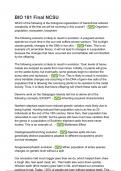Bio 181 ASU (Bio181ASU)
Arizona State University
All 33 results
Sort by
BIO 181 Final NCSU Final Exam Questions and Answers Solved 100%- Correct!! BIO 181 Final NCSU Final Exam Questions and Answers Solved 100%- Correct!!

-
NBCE Part 1 General Principles Biochemistry Exam Questions and Answers Latest 2023 (60 Questions) | NBCE Part 1 General Principles Biochemistry Exam Questions and Answers Latest 2023
- Exam (elaborations) • 12 pages • 2023
-
- $5.49
- + learn more
NBCE Part 1 General Principles Biochemistry Exam Questions and Answers Latest 2023 (60 Questions) | NBCE Part 1 General Principles Biochemistry Exam Questions and Answers Latest 2023 60 questions and answers related to biochemistry, covering topics such as electron transport system, Krebs cycle, glycolysis, enzymes, phosphorylation, isomerases, inhibitors, and rate-limiting enzymes. The questions are useful for students preparing for the NBCE Part 1 exam. The document also mentions the Nurs...
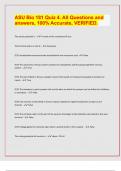
-
ASU Bio 181 Quiz 4. All Questions and answers, 100% Accurate, VERIFIED.
- Exam (elaborations) • 4 pages • 2023
- Available in package deal
-
- $7.99
- + learn more
ASU Bio 181 Quiz 4. All Questions and answers, 100% Accurate, VERIFIED. The action potential is: - -A result of the movement of ions The terminal web is a site of: - -Exocytosis (T/F) Acetylcholine esterase breaks acetylcholine into muscarinic acid - -False (T/F) The autonomic nervous system contains the sympathetic and the parasympathetic nervous system. - -True (T/F) The axon hillock in the pre-synaptic neuron fires based on temporal and spatial summation of inputs. - -True ...
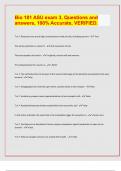
-
Bio 181 ASU exam 3, Questions and answers, 100% Accurate, VERIFIED.
- Exam (elaborations) • 5 pages • 2023
- Available in package deal
-
- $7.99
- + learn more
Bio 181 ASU exam 3, Questions and answers, 100% Accurate, VERIFIED.
ASU BIO 181 MODULE 1 upto 6 COMPLETED 2023 GRADED A+
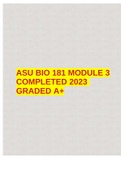
-
ASU BIO 181 MODULE 3 COMPLETED 2023 GRADED A+
- Exam (elaborations) • 4 pages • 2023
- Available in package deal
-
- $8.49
- + learn more
ASU BIO 181 MODULE 3 COMPLETED 2023 GRADED A+ Bio 181 ASU exam 3 1. T or F: Potassium ions are at high concentrations inside of cells, including neurons: True 2. The action potential is a result of:: the movement of ions 3. The post-synaptic cell can be:: in glands, muscle cells and neurons 4. Th resting potential of a neuron is: -60mV 5. T or F: The cell body refers to the part of the neurons that begin at the dendrites and extend to the axon terminal: false 6. T or F: Voltage gated ...
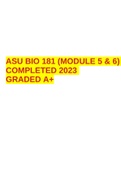
-
ASU BIO 181 (MODULE 5 & 6) COMPLETED 2023 GRADED A+
- Exam (elaborations) • 3 pages • 2023
- Available in package deal
-
- $7.69
- + learn more
ASU BIO 181 (MODULE 5 & 6) COMPLETED 2023 GRADED A+ ASU BIO 181 (MODULE 5 & 6) 1. The other point where MAPK can become active is ____________ of the cell cycle.: M-PHASE 2. For a cell to respond to a ligand released from a cell and uses the circulatory system to get to the responding cell it is called ____________ communication.: ENDOCRINE 3. There are two basic forms of cytoplasmic signaling (i.e. signal transduction). One uses ____________ and the other uses ____________.: CALCIUM S...
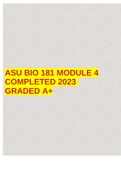
-
ASU BIO 181 MODULE 4 COMPLETED 2023 GRADED A+
- Exam (elaborations) • 6 pages • 2023
- Available in package deal
-
- $9.09
- + learn more
ASU BIO 181 MODULE 4 COMPLETED 2023 GRADED A+ ASU BIO 181 Exam 4 1. Locomotion: Movement of an entire animal 2. Muscle fibers: long, slender cells that make up vertebrate skeletal and cardiac muscle 3. myofibrils: fibers that make up muscles 4. Sarcomeres: parts of myofibrils-alternating light and dark bands 5. Sliding filament model: contraction of the muscle is dependent on how the sarcomeres shorten 6. Actin: Thin filaments (sarcomere protein) 7. Myosin: Thicker filaments (sarcome...
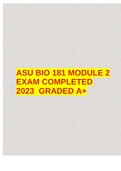
-
ASU BIO 181 MODULE 2 EXAM COMPLETED 2023 GRADED A+
- Exam (elaborations) • 7 pages • 2023
- Available in package deal
-
- $8.99
- + learn more
ASU BIO 181 MODULE 2 EXAM COMPLETED 2023 GRADED A+ ASU BIO 181 Exam 2 1. Specifically in a cell where does Glycolysis occur?: Cytoplasm 2. T/F The cell does not need ATP to survive.: False 3. Where is carbon dioxide produced?: Mitochondrial matrix 4. T/F The citric acid/Kreb's cycle breaks down carbohydrates into CO2.: True 5. T/F FADH2 results as one of the products of the citric acid cycle.: True 6. Specifically where in a cell does the citric acid/Kreb's cycle occur?: Mitochondrial...
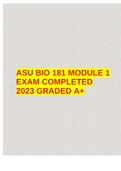
-
ASU BIO 181 MODULE 1 EXAM COMPLETED 2023 GRADED A+
- Exam (elaborations) • 7 pages • 2023
- Available in package deal
-
- $8.99
- + learn more
ASU BIO 181 MODULE 1 EXAM COMPLETED 2023 GRADED A+ ASU Bio 181 Exam 1 1. The association of ribosomes with _____ invaginations would support the _____ theory.: membrane, endomembrane 2. After a cell is pancake shaped in a cell culture dish, the order of events that occurs as a cell walks is?: filapodia, lamellipodia, cell muscle, retraction fiber 3. T/F It is presumed that the peroxisomes evolved in these primitive, proto-eukaryotes to remove oxygen, which was toxic to the primitive cells...

Do you wonder why so many students wear nice clothes, have money to spare and enjoy tons of free time? Well, they sell on Stuvia! Imagine your study notes being downloaded a dozen times for $15 each. Every. Single. Day. Discover all about earning on Stuvia

